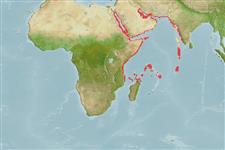Teleostei (teleosts) >
Acanthuriformes (Surgeonfishes) >
Acanthuridae (Surgeonfishes, tangs, unicornfishes) > Acanthurinae
Etymology: Zebrasoma: Derived from Zebra = African horse + Greek, soma = body; referring to the stripes (Ref. 45335).
More on author: Blyth.
Environment: milieu / climate zone / depth range / distribution range
Ecology
Marine; reef-associated; depth range 0 - 20 m (Ref. 9710), usually 2 - 20 m (Ref. 27115). Tropical; 24°C - 28°C (Ref. 27115); 31°N - 14°S, 34°E - 81°E (Ref. 57256)
Western Indian Ocean: Red Sea to the Persian Gulf; recorded from Maldives (Ref. 11303).
Size / Weight / Age
Maturity: Lm ? range ? - ? cm
Max length : 36.7 cm TL male/unsexed; (Ref. 97602); common length : 10.0 cm TL male/unsexed; (Ref. 5450)
Often found in groups in coral-rich areas (Ref. 9710) or on rocky bottoms (Ref. 30573). It small and numerous pharyngeal teeth suggest a diet that consists mainly of filamentous algae (Ref. 33204). Occasionally caught by traps and trawls (Ref. 68964).
Life cycle and mating behavior
Maturity | Reproduction | Spawning | Eggs | Fecundity | Larvae
Carpenter, K.E., F. Krupp, D.A. Jones and U. Zajonz, 1997. FAO species identification field guide for fishery purposes. Living marine resources of Kuwait, eastern Saudi Arabia, Bahrain, Qatar, and the United Arab Emirates. FAO, Rome. 293 p. (Ref. 13710)
IUCN Red List Status (Ref. 130435: Version 2024-1)
Threat to humans
Harmless
Human uses
Fisheries: commercial; aquarium: commercial
Tools
Special reports
Download XML
Internet sources
Estimates based on models
Preferred temperature (Ref.
123201): 24.8 - 29.2, mean 27.1 °C (based on 222 cells).
Phylogenetic diversity index (Ref.
82804): PD
50 = 0.5078 [Uniqueness, from 0.5 = low to 2.0 = high].
Bayesian length-weight: a=0.02344 (0.01123 - 0.04892), b=2.96 (2.79 - 3.13), in cm total length, based on LWR estimates for this (Sub)family-body shape (Ref.
93245).
Trophic level (Ref.
69278): 2.0 ±0.00 se; based on food items.
Resilience (Ref.
120179): Medium, minimum population doubling time 1.4 - 4.4 years (Preliminary K or Fecundity.).
Fishing Vulnerability (Ref.
59153): Low to moderate vulnerability (27 of 100).
Nutrients (Ref.
124155): Calcium = 36.8 [16.7, 111.9] mg/100g; Iron = 0.784 [0.286, 1.806] mg/100g; Protein = 18.2 [16.9, 19.5] %; Omega3 = 0.126 [0.061, 0.262] g/100g; Selenium = 12.3 [4.3, 42.2] μg/100g; VitaminA = 39.1 [9.1, 154.5] μg/100g; Zinc = 1.83 [0.83, 3.28] mg/100g (wet weight);
